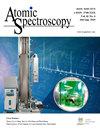镍基高温合金铸锭元素分布及定量偏析程度的表征
IF 2.3
2区 化学
Q1 SPECTROSCOPY
引用次数: 2
摘要
:通过熔炼制备的镍基高温合金不能消除偏析缺陷。因此,研究元素含量分布和偏析程度有助于指导工艺改进和质量控制。在本研究中,用微束X射线荧光光谱法分析了直径为485mm的变形高温合金圆柱形电渣重熔锭的横截面,并采用连续逐点模式获得了高稳定性和高精度。表征了铸锭从边缘到中心的元素含量分布和定量偏析程度。计算了各元素的最大正偏析、最大负偏析、统计偏析度和统计一致度,从不同角度定量表征了偏析程度,它们与元素含量分布呈现出相同的趋势。金相学和扫描电子显微镜能谱分析结果表明,从铸锭边缘到中心,枝晶间和枝晶臂中的枝晶组织和析出相存在差异,这在很大程度上解释了元素含量的分布。本文章由计算机程序翻译,如有差异,请以英文原文为准。
Characterization Of The Element Distribution And Quantitative Segregation Degree Of Nickel-Based Superalloy Ingot
: Segregation defects cannot be eliminated from nickel-based superalloy prepared by smelting. Thus, studying the element-content distribution and segregation degree is helpful to guide process improvement and quality control. In this study, the cross section of a cylindrical electro-slag remelting ingot of a wrought superalloy with a diameter of 485 mm was analyzed by micro-beam X-ray fluorescence spectrometry, and continuous point-by-point mode was used to obtain high stability and accuracy. The element-content distribution and quantitative degree of segregation from the edge to the center of the ingot were characterized. The maximum positive segregation, maximum negative segregation, statistic segregation degree, and statistic conformity degree were calculated for each element to quantitatively characterize the degree of segregation from different points of view, and they showed the same trend as the element-content distribution. The results of metallography and scanning electron microscopy with energy-dispersive spectroscopy (SEM-EDS) showed that there were differences in the dendritic microstructures and precipitated phases in the interdendrites and dendritic arms from the edge to the center of the ingot, which explain the element-content distribution largely.
求助全文
通过发布文献求助,成功后即可免费获取论文全文。
去求助
来源期刊

Atomic Spectroscopy
物理-光谱学
CiteScore
5.30
自引率
14.70%
发文量
42
审稿时长
4.5 months
期刊介绍:
The ATOMIC SPECTROSCOPY is a peer-reviewed international journal started in 1962 by Dr. Walter Slavin and now is published by Atomic Spectroscopy Press Limited (ASPL). It is intended for the rapid publication of both original articles and review articles in the fields of AAS, AFS, ICP-OES, ICP-MS, GD-MS, TIMS, SIMS, AMS, LIBS, XRF and related techniques. Manuscripts dealing with (i) instrumentation & fundamentals, (ii) methodology development & applications, and (iii) standard reference materials (SRMs) development can be submitted for publication.
 求助内容:
求助内容: 应助结果提醒方式:
应助结果提醒方式:


